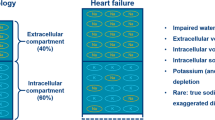Abstract
Two methods have been suggested by Daugirdas and Schneditz (the rate equation), and Smye for predicting true equilibrated Kt/V (eKt/V) without the need for obtaining a blood sample 60 min after hemodialysis (HD). We compared the accuracy of these two methods when applied to pediatric HD. Thirty-eight standard pediatric HD sessions in 15 patients, (6 male, 9 female), aged 14.5±3.3 years, were analyzed. Kt/V was calculated by formal variable-volume single-pool urea kinetic model with post-HD urea taken at the end of HD (single-pool Kt/V), and with equilibrated urea (Ceq) taken 60 min after the end of HD (eKt/V). eKt/V was predicted by the rate equation from single-pool Kt/V and by the Smye method from predicted Ceq. Mean values obtained by both the rate equation (1.44±0.32, P>0.05) and by the Smye method (1.47±0.36, P>0.05) were similar to eKt/V (1.42±0.30), but correlation between results from the rate equation and eKt/V (r=0.863) was higher than between those from the Smye method and eKt/V (r=0.654). Average absolute error of the rate equation in predicting eKt/V was 0.118±0.114 (median 0.095) Kt/V units and 8.53%±8.36% (median 6.29%), while for the Smye method it was significantly higher [0.221±0.180 (median 0.190) Kt/V units, P=0.001; 16.49%±15.98% (median 11.88%) P=0.004]. High correlation between eKt/V and results from the rate equation indicates that urea rebound (expressed as ΔKt/V) is a function of the rate of dialysis (K/V). To test this, we analyzed the relationship of K/V and other parameters (session duration, body mass index, ultrafiltration rate, blood flow, and urea distribution volume) with ΔKt/V. The only significant (P<0.01) and highest correlation (r=0.442) was found for K/V. We conclude that in children on chronic HD, the rate equation is a better predictor of eKt/V than the Smye method, and that HD efficiency is the strongest determinant of postdialysis urea rebound in children.
Similar content being viewed by others
Author information
Authors and Affiliations
Additional information
Received: 28 April 1998 / Revised: 20 July 1998 / Accepted: 6 October 1998
Rights and permissions
About this article
Cite this article
Marsenić, O., Peco-Antić, A. & Jovanović, O. Comparison of two methods for predicting equilibrated Kt/V (eKt/V) using true eKt/V value. Pediatr Nephrol 13, 418–422 (1999). https://doi.org/10.1007/s004670050632
Issue Date:
DOI: https://doi.org/10.1007/s004670050632




